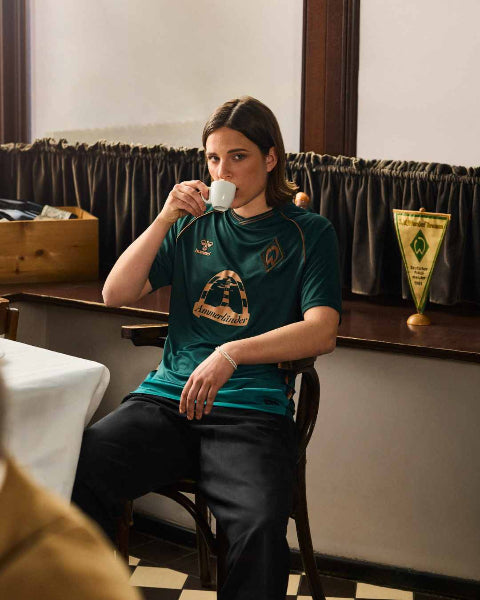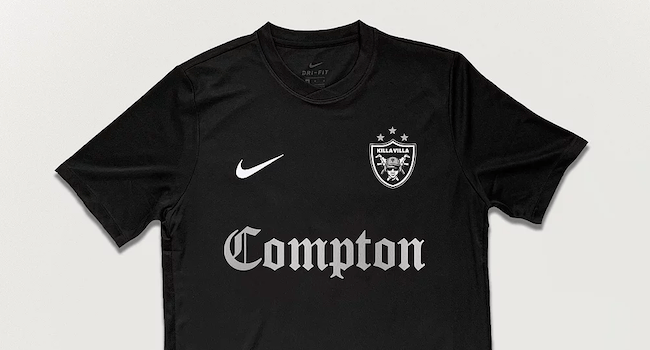Recently added
Vintage shirts
Concept kits
Legends
The Puma international shirts aren’t as bad as you think
by Phil Delves February 05, 2022 8 min read

It was 2018 all over again.
As Puma released their latest batch of international away shirts, the football shirt community exploded with anger.
.@pumafootball are debuting their new look away shirts for @EURO2020 today, and they are splitting opinion 😳
— Football Shirt Collective (@thefootballsc) April 22, 2021
First up we have the Azzurri 🇮🇹 pic.twitter.com/Uj0EK2BF5T
This was yet another example of a big brand rolling out “copy and paste” templates for major teams, with some nations like Switzerland and Czech Republic being uncomfortably close in terms of aesthetic. Like 2018, there were a frustrating amount of white shirts in the mix, and making matters even worse was the fact that the football shirt darlings of the past couple of years, Italy, were dragged into the plain mire.
As reports came out that the new Puma international shirts would be used for Euro 2020 later this Summer, the final nail was slammed into the coffin. Puma had undone all the goodwill they had built up over recent years, and they were taking on the mantle they held just a few years ago as a manufacturer that embodied everything wrong with the modern shirt game.
Now, in truth there were some people bucking the trend and declaring their love for some or all of the new 2021 kits, but from my vantage point these bold members of the community were outnumbered considerably by those strongly opposed to the new Puma international shirts.
Do the minority actually have a point, though? Are these new Puma kits really as bad as they seem at first glance?
Away from the heart
Let’s talk first about crest and logo placement.
We got our first look at Italy and @pumafootball's new away shirt design last night 🇮🇹 pic.twitter.com/NBQHyk75N6
— Football Shirt Collective (@thefootballsc) June 1, 2021
Arguably the most controversial design aspect of the new Puma kits is the placement of the national federation crests. Across the new designs, Puma showed something of an abandon for the traditional, ‘over the heart’ position of the crest which has been a staple in football shirts for generations.
Some designs, like Italy’s, opted for an intriguing new look which saw the crest and Puma logo either side of a thin line, in the sort of configuration that you’d expect to see on a graphic accompanying a collaboration announcement. In Austria’s case, the federation crest appears to be completely missing from the kit at first glance. Closer inspection reveals a radical new approach, with the crest used as a subliminal pattern throughout the body of the black design.
But the Czech Republic’s shirt looks very similar to their Swiss opponents 👀🇨🇿 pic.twitter.com/fEGzY88elC
— Football Shirt Collective (@thefootballsc) April 22, 2021
Switzerland and the Czech Republic took the biscuit for many however. For both designs, the Puma logo takes prominence in the totem pole of manufacturer logo, team name detailing and federation crest, with the big cat living up to its name and dwarfing the crests in both instances. Fans were predictably frustrated at this imbalance, and there were echoes of the discussion that accompanied the release of Turkey’s latest home and away shirt from Nike, where the Swoosh controversially sat above the symbol of Turkey.
Though the placement of the Puma logo above the federation crest and the sizing difference of said logo compared to the crests is hard to defend, Puma’s move ought to be seen as something of a refreshing change of direction.
Brands occasionally trot out a centralised crest every now and then, but by and large we can expect the manufacturer logo to sit on the right of the shirt (or the left as you look at it straight on), and the team crest to sit on the left. Puma’s approach across their latest range rips up the rulebook, and though the final results lack nuance in some cases (I can’t quite forgive the tiny size of the Czech Republic crest in relation to the Puma logo), it’s exciting to see a brand actually step out of the comfort zone.
#ThrowbackThursday: Those were the days at @FCBayern ...🤣#MiaSanMia pic.twitter.com/qjjkJIwKNl
— Lothar Matthäus (@LMatthaeus10) November 15, 2017
Funnily enough, I’d argue there’s actually something of a nostalgic feel to the direction. Many club and national team shirts of the past were completely missing crests (see Bayern Munich shirts for the majority of the 80s, for example), making the Austria away look more like an old-school kit than might appear at first glance. 90s shirts were notorious for moving crests to interesting places like the sleeves (see multiple late 90s Juventus or Italy shirts), and many teams moved crests into positions which were anything but over the heart.
If anything, I’m surprised that some of the new looks are able to get past FIFA regulations. Perhaps we’ll see a future ban (Puma have a history in that department…) and subsequently hastily reworked designs, but regardless Puma are bringing plenty of food for thought, even if that food is a little hard to stomach.
The pendulum swings back
Many readers will be familiar with the concept of the football shirt pendulum, but for those who have been fortunate enough to avoid my ramblings from the past, the football shirt pendulum is the idea that brands will typically follow a busier, more ‘modern’ shirt design with something more reserved and traditional the following season, before returning to something more ‘disruptive’ the year after etc.
I’m far from the first person to observe this sort of pattern, but it’s something I’ve been increasingly aware of in recent years. Though there are several exceptions to the rule, the pendulum is the reason we shouldn’t be surprised that Arsenal will go for something a little bit cleaner next year for their home shirt (after a traditional look in 2019/20, and something with a distinct pattern in 2020/21), or that Nike will upset the apple cart a bit more next season with Liverpool’s home shirt, following the relatively plain home this year.
Zooming out further, you can apply this idea of a pendulum more broadly to the football shirt industry as a whole, which tends to oscillate between different design approaches every 5-10 years.
As good as Puma were in the last round of international releases, it’s no surprise that the busy, pattern-oriented looks have been succeeded by something on the understated end of the spectrum. Naturally, us kit fanatics tend to gravitate towards the crazier sorts of designs, but we are reaching something of a saturation point in 2021.
It’s (officially) here, and it’s perfect.
— Football Shirt Collective (@thefootballsc) September 21, 2020
The full Nigeria x Nike 2020 collection 🇳🇬 pic.twitter.com/E8eUUSL45k
The post-Nigeria 2018 bubble is arguably about to burst, as more and more teams and brands try to capture the zeitgeist with shirts that often look like they were manufactured to generate ‘numbers’ on social media. The technique is often a slam dunk for appealing to the broad, football shirt-loving audience, but more traditional supporters and shirt fans are often left frustrated in the dust of this rapid and seemingly incessant change.
On a personal note, I’ve been a vocal advocate for a progressive approach to football shirts where traditions aren’t used as shackles for creative freedom, but I can’t deny that the trend of bright and beautiful kits is becoming a regrettable trope.
Again, I won’t argue that Puma’s new shirts are better pound-for-pound than something like the last set of Italy kits, but they are symbols of the change we will likely see in the industry very soon, as the likes of Nike, adidas and Puma shift towards more refined kits which major more on technological innovations and traditional approaches to things like colour and details.
These cleaner kits are often the ones which stand the test of time, and though they won’t generate the same level of excitement on Twitter as something more brash, they are an important part of the kit eco-system nonetheless.
Marketing matters
I want to finish this piece by suggesting that Puma sold themselves short this year.
Kit release marketing isn’t in a particular good place at the moment, but pictures of most of the new Puma kits failed to capture the imagination. Most people, myself included, completely failed to notice the pleasing subliminal patterns that can be seen up close on each of the designs, and though many people won’t be persuaded by anything that isn’t in your face, something as seemingly plain as the Switzerland shirt goes up several points in my eyes when you notice the Swiss flags within the material (shoutout to Chris who runs the account @ChatShirt for the image here).
Suisse Credit? Or creatively bankrupt?#ChatShirt.
— 𝗖𝗵𝗿𝗶𝘀 𝗖𝗵𝗮𝘁𝘀 𝗦𝗵𝗶𝗿𝘁 (@ChatShirt) April 26, 2021
7pm. pic.twitter.com/z4Y6koY7e5
For Italy’s away shirt, Puma trotted out some unfortunate promo images which showcased the new design in the surroundings of a training ground. Given that many people criticised the new shirt as looking more like a training shirt, the practice pitch setting did nothing to quash frustrations. A more creative approach which majored on the bold, new innovative look of the Puma international shirts would have set things off on a better foot.
Next up it’s Austria, who have their national crest across the shirt 🇦🇹 pic.twitter.com/uq62kciF0j
— Football Shirt Collective (@thefootballsc) April 22, 2021
I was also quite happy to see bespoke treatment for the team names on the front of the kits. The ‘Italia’, ‘Österreich’, ‘Suisse’ and ‘Czech Republic’ wordmarks were hated by many, but I enjoyed seeing the team specific fonts not least for their interesting placement at the front of the shirt, on top of the fact each team name was written in a style unique for the team.
These words, as unusual as they are in terms of placement, are a strength of these Puma international shirts in my mind. The brand would have done well to focus a little more on these, and though many people joked that the names were there in case people forget which team the shirt belong to, I’d argue that from both a design and storytelling perspective they are worth highlighting. Some of the typefaces are more interesting than others, but even something like the seemingly mundane font used for the Swiss shirt is actually Helvetica, the world-famous font that is as Swiss as the shirt it's been used on. It's a far from random decision, but it will go largely unnoticed, and Puma only have themselves to blame.
In a small way, the team names on the front remind me of many a good jersey or uniform from American sports like the NFL, NBA or 90s MLS. Team names on the fronts of shirts, even ones that are relatively low-key like on these Puma international shirts, are something I’d like to see more of in football, and though there are obvious regulation hoops to jump through, experimentation like this from Puma is a step in the right direction.
When the Euros plays out later this year, it’s unlikely we’ll see much praise for these new Puma shirts. Accounts both inside and outside the football shirt space will likely point the finger and laugh at yet another set of plain white t-shirts for teams who’ve been fleeced by a greedy manufacturer.
Though I won’t be rushing to buy the Italy or Switzerland away shirts, I don’t think they’re the worst football shirts we’ll see this year — far from it.
Phil Delves
As Head of Content, Phil is the creative playmaker of the team, covering every angle of football shirt news in our blogs and weekly Newsletter. Whether it's telling your fakes from your authentics, or deep dives into the newest football shirts designs, Phil will have all your football shirt content needs covered.
Leave a comment
Sidebar
- Premier League football shirts
-
Other English clubs
- Birmingham City
- Blackburn Rovers
- Charlton Athletic
- Coventry City
- Derby County
- Hull City
- Ipswich Town
- Leicester City
- Middlesbrough
- Millwall
- Norwich City
- Portsmouth
- Preston North End
- Queens Park Rangers
- Sheffield United
- Sheffield Wednesday
- Southampton
- Stoke City
- Swansea City
- Watford
- West Bromwich Albion
- Scottish clubs
- Italian club shirts
- Spanish club shirts
- German club shirts
- International
- French club shirts
- Rest of the world
-
Legends
- Adriano
- Alessandro Del Piero
- Andrey Arshavin
- Alvaro Recoba
- Bobby Moore
- Bryan Robson
- Bukayo Saka
- Clarence Seedorf
- Cristian Vieri
- Cristiano Ronaldo
- David Beckham
- David James
- David Seaman
- David Ginola
- Dennis Wise
- Dennis Bergkamp
- Didier Drogba
- Dimitar Berbatov
- Diego Maradona
- Edgar Davids
- Eric Cantona
- Fernando Torres
- Freddie Ljungberg
- Gabriel Batistuta
- Gianluca Vialli
- Gianluigi Buffon
- Giovanni Elber
- Frank Lampard
- Francecso Totti
- Haaland
- Harry Kane
- Hidetoshi Nakata
- Ian Wright
- Jari Litmanen
- Ji Sung Park
- Juninho
- Jurgen Klinsmann
- Kaka
- Landon Donovan
- Lionel Messi
- Lothar Mattaus
- Luis Figo
- Mark Viduka
- Matt Le Tissier
- Mesut Özil
- Michael Owen
- Mikel Arteta
- Neymar
- Nicolas Anelka
- Nwankwo Kanu
- Paolo Di Canio
- Paolo Maldini
- Patrick Vieira
- Rafael Van der Vaart
- Raul
- Riquelme
- Rivaldo
- Robert Pires
- Roberto Baggio
- Robbie Fowler
- Ronaldo Nazario
- Ronaldinho
- Roy Keane
- Rudi Voller
- Ruud Gullit
- Ryan Giggs
- Santi Carzola
- Steve Bull
- Steven Gerrard
- Teddy Sheringham
- Thierry Henry
- Tony Adams
- Toto Schillaci
- Tugay
- Wayne Rooney
- Xabi Alonso
- Zinedine Zidane
- Zola
- Brands
Subscribe
Sign up to get the latest on sales, new releases and more …













